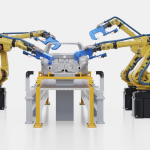Same-day fulfillment doesn’t just depend on speed within a warehouse, it depends on coordination across warehouses. As fulfillment networks become more distributed, companies are under pressure to manage not just throughput, but system-wide equilibrium. That means rerouting trailers, shifting labor, and adjusting order waves based on real-time friction. A new class of AI-driven orchestration tools is making that possible.
From Batch Planning to Adaptive Execution
Traditional fulfillment planning was largely static—forecast demand, schedule labor, allocate outbound slots. But today’s networks are too volatile for fixed logic. Traffic delays, last-minute orders, SKU imbalances, and staffing gaps now require execution-level flexibility.
For instance, Target’s sortation centers offer a glimpse of what’s possible. The retailer uses regional sortation hubs to pool e-commerce volume from nearby stores, then uses AI to dynamically assign packages to outbound routes based on delivery time windows and zone density. This has allowed Target to reclaim control over last-mile performance without building standalone fulfillment centers.
GXO, one of the largest contract logistics providers globally, is piloting real-time load balancing across its warehouse clusters using machine learning. When a site faces congestion—due to a labor shortfall or unexpected surge—orders can be automatically reallocated to neighboring facilities with excess capacity. The system adjusts pick wave start times, modifies trailer load plans, and even flags critical orders for priority treatment upstream.
The New Load Balancing Stack
Real-Time Node Telemetry: Every site broadcasts live data on labor availability, pick velocity, dock congestion, and inventory status. This telemetry feeds into a centralized AI engine that continuously evaluates load distribution against service commitments and cost constraints.
Predictive Throughput Forecasting: By learning from past events, weather disruptions, or day-of-week patterns, the system anticipates future bottlenecks before they trigger SLA breaches—rebalancing workload proactively, not reactively.
Dynamic Routing & Trailer Sequencing: AI models optimize not just which orders ship where, but when and how. For example, outbound trailers may be resequenced at short notice to prevent idle wait time at downstream sortation hubs or carrier depots.
Labor Reallocation Tools: In union-compliant or flex-labor environments, some networks now use predictive shift allocation tools to shift workers between sites or roles with minimal disruption—bridging gaps during high-volume surges.
Integrated Exception Handling: When a delay is detected—say, an inbound truck is 3 hours behind schedule—the system auto-reassigns pick tasks, notifies relevant docks, and updates carrier partners in real time, minimizing ripple effects.
Rethinking “Spare” Capacity as a Strategic Asset
Traditional cost models treat spare labor or facility headroom as waste. But AI-driven networks are turning that notion on its head. When real-time load balancing becomes the norm, what was once “idle” capacity becomes a flexible buffer, an asset that absorbs volatility and protects performance. The question for companies is no longer just how to scale, but how to stay fluid. Because in a multi-node world, the ability to pivot may matter more than the ability to push.





